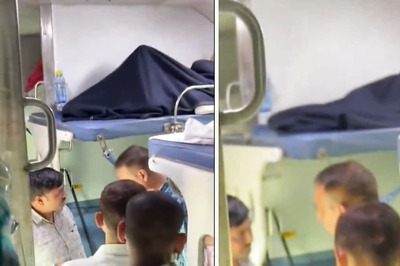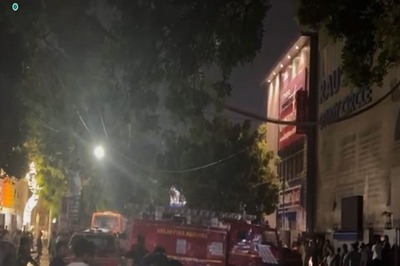
views
It may be India’s national animal and a species accorded the highest status of protection under the law. But Maharashtra, which has “surplus” tigers in the state’s tiger capital of Chandrapur district, is looking at drastic solutions like their sterilisation and translocation to mitigate man-animal conflict and habitat pressures.
Senior forest department officials confirmed that a “suggestion” had been sent to the state government to translocate 50 of these big cats from this congested landscape to ones with adequate prey base, protection and habitat interventions. Also, to deal with this problem of plenty, the department has controversially suggested that 20 male tigers be sterilised to curb the growing tiger population in Chandrapur, in the first such measure in India.
Some wildlife experts have also been reported as mooting humane euthanasia for “surplus” tigers.
Chandrapur district, which covers the Tadoba Andhari Tiger Reserve (TATR), is estimated to carry 200 adult tigers, including 63 breeding females. This figure also includes semi-adult tigers of dispersing age. These animals are largely concentrated in the TATR, the Bramhapuri forest division, and areas around Chandrapur city.
The 2018 tiger census had estimated Maharashtra’s tiger numbers at 312 out of India’s 2,967. Of this, Chandrapur’s count was around 160, including 40 in Bramhapuri, which is not a protected area.
Maharashtra has six tiger reserves, but the bulk of the tiger population is concentrated in the TATR. On the other hand, the Sahyadri Tiger Reserve (STR), which covers the ecologically-sensitive Western Ghats, has no breeding tigers, making a tiger project without resident tigers! This is because of bauxite mining projects affecting the STR’s connectivity with tiger source populations in southern states.
Brahmapuri has 610 villages, of which half are in close proximity to the jungles, and consist of about 44 adult and 20 sub-adult tigers. It covers a fragmented forest landscape, making it a forest manager’s nightmare when it comes to managing habitat pressures and conflict. Any attacks on humans and livestock lead to forest officials and staff being confronted by angry villagers.
Officials said the impressive rise in numbers at Chandrapur, which has a geographical area of 11,441 sq km, with a 5,206 sq km area under forests, has come with a flipside—that of a rise in conflict with humans. As tigers are territorial animals, they compete for territory, leading to fights and deaths.
A rise in tiger numbers has meant that these apex predators have strayed dangerously close to human habitation and Chandrapur city, raising the spectre of man-animal conflict.
A tigress and her three cubs had made their home in the forest inside the premises of the Chandrapur super thermal power station, causing panic. In the last six years, 81 people have been killed in tiger attacks.
This has prompted the idea of translocating some animals from Chandrapur to other protected areas in Maharashtra, which do not have adequate tiger numbers, like the Navegaon Nagzira tiger reserve and the Pranahita Wildlife Sanctuary in Gadchiroli district. While easing the pressure on the Chandrapur landscape, this will repopulate these habitats with tigers.
But this is easier said than done. Though restocking dwindling tiger populations using tigers from surplus areas like in the Panna and Sariska reserves, is different from relocating “problem” individuals, Maharashtra’s experiments with the later have ended rather badly.
For instance, in 2019, a three-year old tigress captured from Bramhapuri after a conflict with humans, and released into the wild at the Melghat Tiger Reserve (MTR) in Amravati was blamed for attacking men and animals. This led to her being tranquilised and re-captured.
In 2017, another two-year-old problem tigress from Brahmapuri, who was shifted to the Bor Tiger Reserve, was killed by an electrocuted farm fence. Ironically, the tigress was blamed for five human deaths, prompting the forest department to issue orders for shooting her dead.
Though the National Tiger Conservation Authority, a statutory body, has a protocol for translocating tigers from high-density areas to low-density ones, dissenting voices claim translocation and sterlisation are band-aid solutions to larger, complex issues.
Even if any formal proposal has to be debated and cleared by the state government, the Maharashtra State Wildlife Board and the NTCA before it sees the lights of day, critics note that such methods must instead be replaced with a holistic approach.
Sterlisation, a method used to control the population of stray dogs, would amount to interference in nature, and also cause trauma to tigers which will have to be tranquilised, captured, operated upon and released back into the wild.
Identification of individuals for sterlisation procedures will be contentious. It will also not provide an immediate solution to man-animal conflict.
Wildlife activists state that instead of allowing diversion of forest land for coal mines and power plants, and permitting linear projects like roads, Maharashtra must focus on protecting and strengthening tiger dispersal corridors in and around Chandrapur to allow tigers to migrate elsewhere. Translocation, if necessary, can also cover other states in the central Indian landscape, where Chandrapur is located.
Shifting problem animals from one place to another would amount to shifting a problem. Any planned relocation of tigers must take into account the prey base, human presence, and protection measures in the areas where they will be released. Instead of adult tigers who have already marked their territory, the focus should be on shifting sub-adult tigers, who are of dispersing age.


















Comments
0 comment